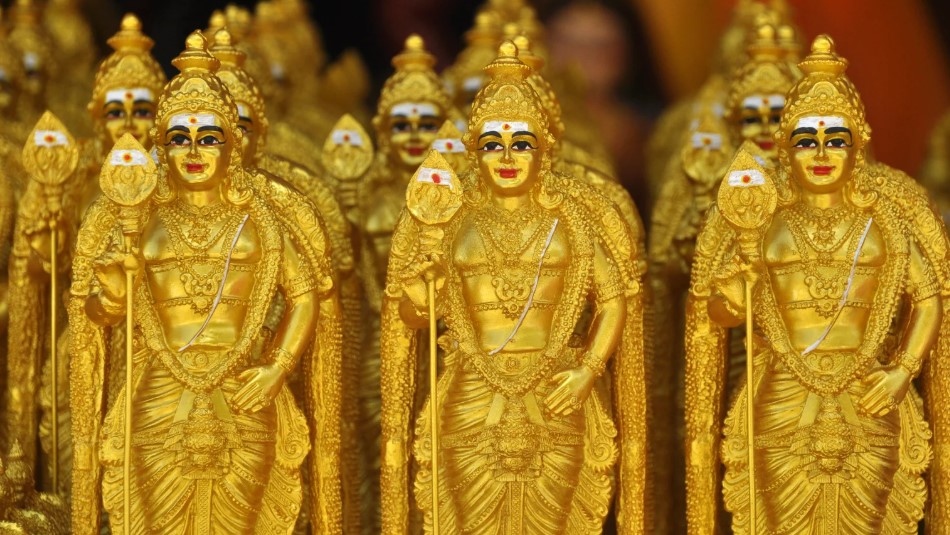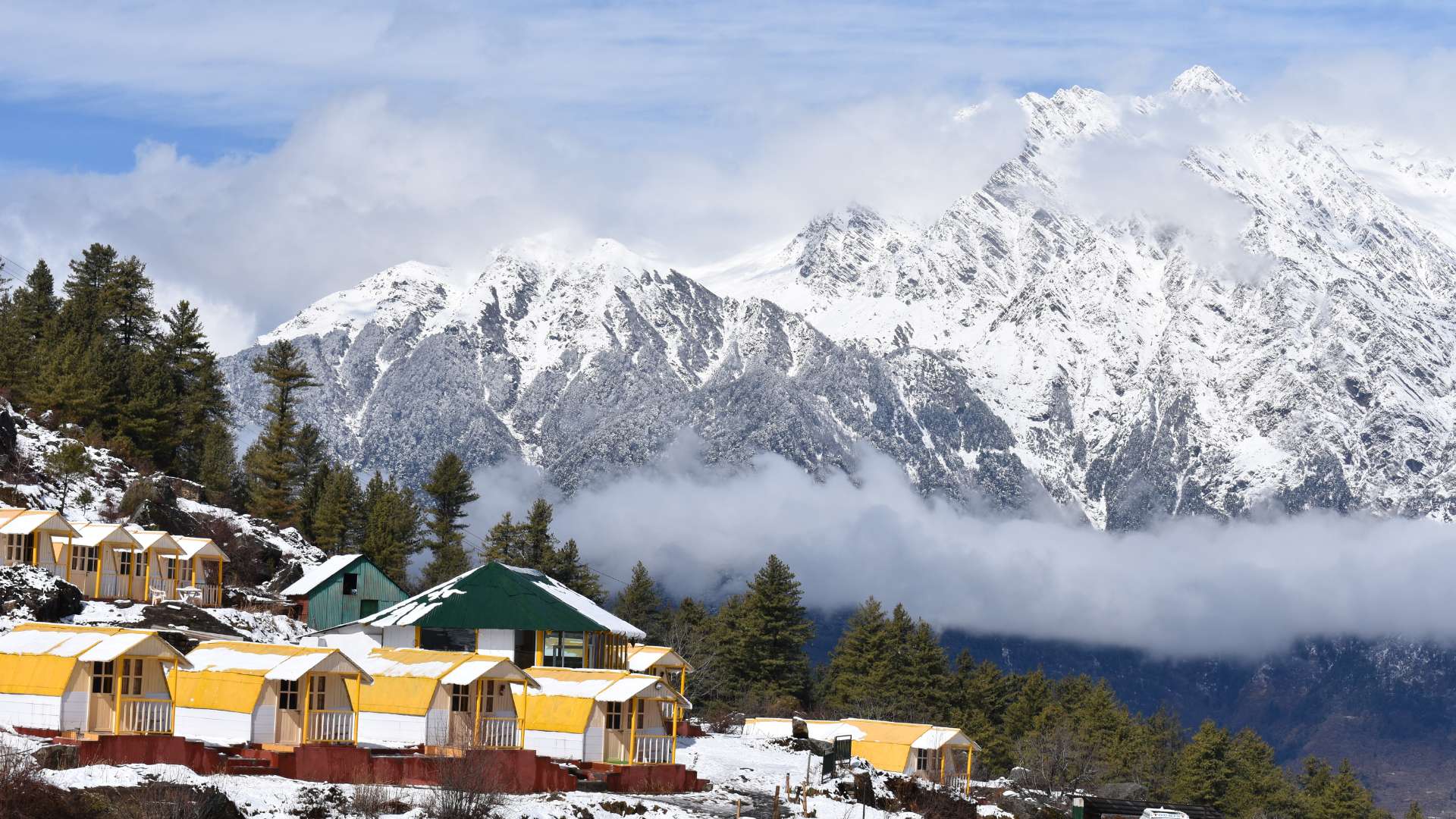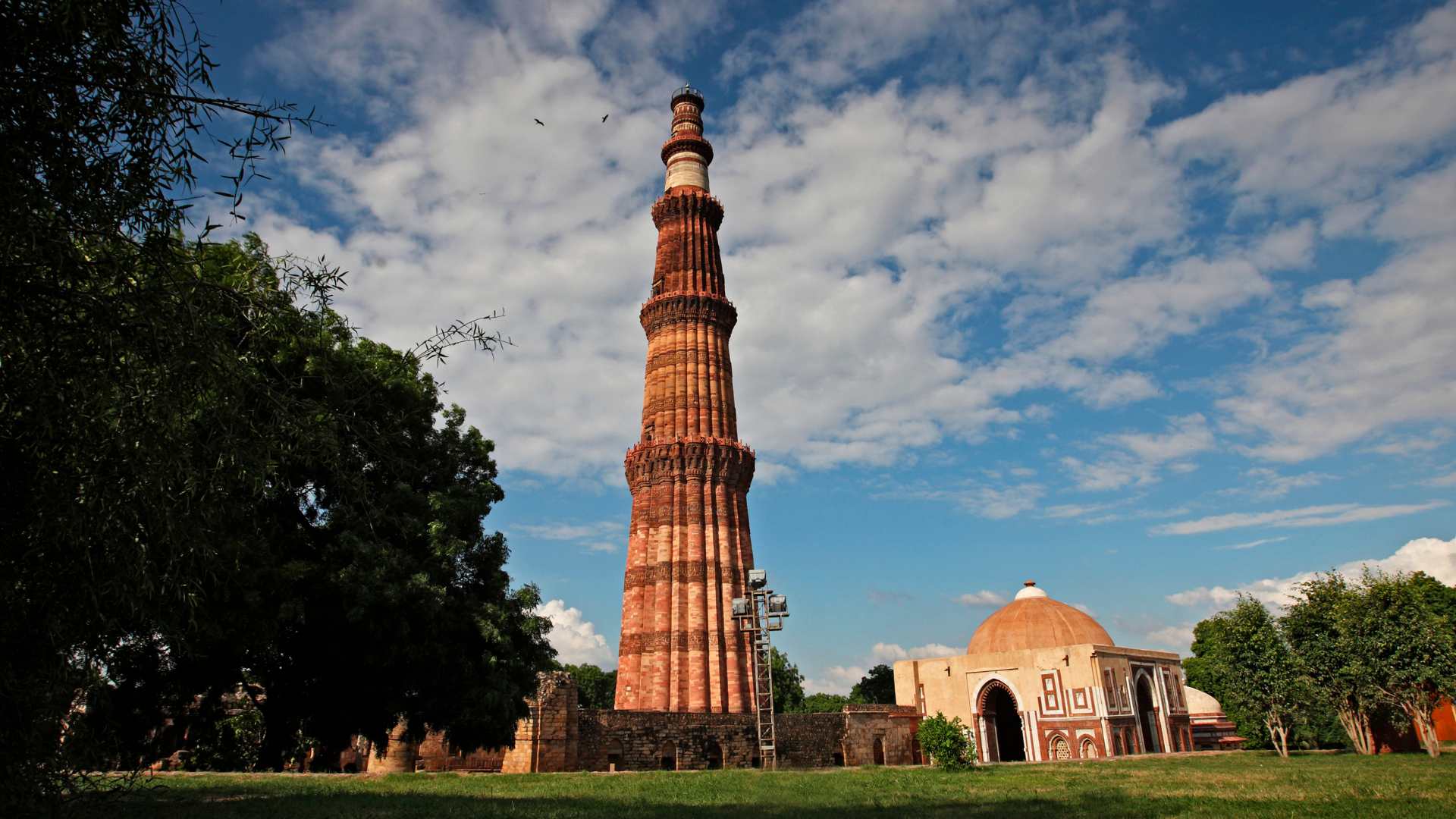Table of Contents
ToggleKarnataka, a land of diverse traditions and cultures, boasts a rich heritage that is vividly reflected in its traditional clothing.
The state’s unique blend of ethnic diversity can be seen through its exquisite fabrics, intricate weaves, and iconic styles that have been passed down through generations.
From the grandeur of Mysore Silk Sarees to the vibrant tribal attire of the Lambani women, each piece of clothing tells a story of Karnataka’s glorious past and its cultural pride.
These traditional outfits are not just garments but are symbolic representations of the customs, festivals, and celebrations that unite communities across the state.
In this article, we’ll explore the top 10 traditional dresses of Karnataka for both men and women that showcase the state’s timeless elegance.
What is the Cultural Significance of Traditional Clothing in Karnataka?
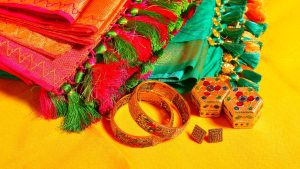
Traditional clothing in Karnataka is more than just attire. It represents the cultural and historical identity of the state.
Each dress, from the Mysore Silk Saree to the Panche, reflects the customs, beliefs, and heritage of the communities that have worn them for generations.
These garments are often worn during festivals, weddings, and religious ceremonies, marking significant life events and cultural practices.
The diversity of the state’s population is also reflected in its clothing, with distinct styles in regions like Coorg, Mysore, and North Karnataka.
These traditional clothes serve as a bridge between the past and the present, showcasing Karnataka’s artistic heritage while continuing to play a role in contemporary celebrations.
How Has Karnataka’s Traditional Attire Evolved Over Time?
Karnataka’s traditional attire has evolved through centuries, adapting to cultural shifts, modern fashion influences, and changes in textiles and weaving techniques.
Historically, garments like the Mysore Silk Saree and Panche were symbols of royal and religious significance. With time, the masses embraced these styles and adapted them for daily wear.
The rise of industrialization brought modern fabrics, lighter versions of traditional outfits, and contemporary designs. Yet, traditional attire remains relevant, especially during festivals and weddings.
Many families still pass down heirloom sarees, and younger generations are reviving old styles with modern touches, ensuring that Karnataka’s cultural attire remains part of everyday life, albeit with new twists.
Why Are Karnataka’s Traditional Sarees So Important for Women?
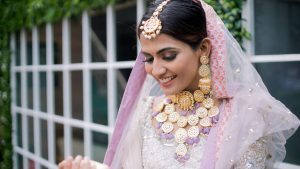
Sarees are an integral part of women’s traditional attire in Karnataka. Garments like the Mysore Silk, Ilkal, and Kanchipuram sarees are not only worn during major festivals, weddings, and religious ceremonies but also symbolize a woman’s cultural identity and pride.
These sarees are often intricately woven with gold zari work and depict traditional motifs such as peacocks, temples, and flowers, making them a reflection of Karnataka’s rich artistic heritage.
The softness and luxury of these fabrics, combined with their deep cultural roots, make sarees an important symbol of femininity, elegance, and respect in society.
Women continue to treasure these sarees, passing them down as family heirlooms from one generation to another.
How Do Tribal Communities in Karnataka Express Their Culture Through Dress?
Tribal communities in Karnataka, such as the Lambani, express their unique cultural identity through vibrant traditional attire.
The Lambani dress, for example, is a colorful garment adorned with mirror work, embroidery, and patchwork, reflecting the semi-nomadic lifestyle and artistic traditions of the tribe.
These dresses are deeply connected to the community’s customs, festivals, and day-to-day life, offering insight into their connection with nature and the environment.
Tribal dresses stand out for their elaborate craftsmanship, often handcrafted by women of the community.
By preserving these traditional outfits, Karnataka’s tribal communities keep their heritage alive, while these garments serve as a visual representation of their cultural pride.
What Role Does Traditional Attire Play During Festivals and Weddings in Karnataka?
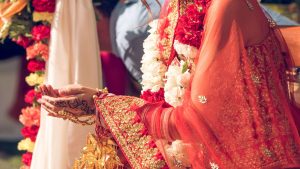
Traditional attire plays a central role in Karnataka’s festivals and weddings, where wearing the appropriate clothing is often considered a sign of respect and cultural adherence.
During major festivals like Ugadi, Dussehra, and Diwali, people across the state dress in traditional garments such as Mysore Silk Sarees, Panche, Sherwani, and Kurta Pyjama.
In weddings, sarees like the Kanchipuram and Mysore Silk are worn by brides, while grooms typically wear Sherwanis or traditional Coorgi attire.
These events are significant occasions where traditional clothes help to reinforce cultural bonds, celebrate heritage, and pass on important customs to future generations, maintaining Karnataka’s rich and vibrant cultural tapestry.
How is Karnataka’s Traditional Attire a Symbol of Cultural Pride?
Karnataka’s traditional attire is a symbol of the state’s cultural pride, reflecting its deep-rooted history, diversity, and artistic mastery.
Clothing like the Mysore Silk Saree, Kuppasa, and Ilkal Saree represent the region’s dedication to craftsmanship, with each garment showcasing intricate weaving techniques and traditional designs.
Wearing these outfits is a way for people to honour their heritage, whether during festivals, weddings, or daily life. Traditional attire fosters a sense of belonging and identity, linking modern Karnataka with its past.
Moreover, these garments are often passed down through generations, ensuring the continuation of cultural practices and the preservation of Karnataka’s rich textile legacy for future generations.
Top 10 Karnataka Traditional Dress
1. Mysore Silk Saree
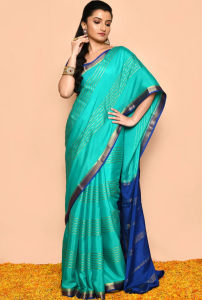
Image – Source
The Mysore Silk Saree is one of Karnataka’s most iconic traditional outfits for women. Woven from the finest silk, it’s known for its soft texture and lustrous sheen, making it the go-to choice for women during festivals, weddings, and religious events.
The saree is adorned with gold zari work, enhancing its luxurious appeal. Traditionally, the Mysore silk saree has been a symbol of royalty and elegance for centuries.
It is available in vibrant hues like royal blue, red, and green and often features traditional motifs such as peacocks and flowers.
This saree remains a favourite for formal occasions, symbolizing the state’s rich textile heritage.
Mysore Silk Saree Details
| Feature | Details |
| Dress Name | Mysore Silk Saree |
| Cultural Significance | Worn by women during major festivals, weddings, and religious ceremonies, symbolizing Karnataka’s rich heritage. |
| Fabric & Textiles | Made from 100% pure silk with a smooth texture and natural sheen, often embellished with gold zari work. |
| Design Features | Features intricate borders with gold zari and traditional motifs like peacocks, temples, or flowers. |
| Colour Palette | Vibrant hues like red, blue, green, and royal purple, along with softer shades like cream and ivory, with golden borders. |
| Wearing Style | Draped traditionally, with pleats at the waist and the pallu elegantly draped over the shoulder. |
| Occasions for Use | Commonly worn during Karnataka festivals like Dussehra, weddings, and formal functions. |
| Accessories | Paired with traditional gold jewellery, including necklaces, earrings, bangles, and anklets. |
| Craftsmanship | Handcrafted using fine silk weaving techniques, with rich zari borders and intricate patterns. |
| Cultural Importance | Represents Karnataka’s historical and textile traditions, a symbol of luxury, status, and cultural pride. |
| Modern Variations | Lighter versions with contemporary designs are available for casual and formal occasions. |
| Embroidery and Zari Work | Enhanced with rich zari (gold or silver thread) embroidery, highlighting Karnataka’s textile artistry. |
| Traditional Weaving Techniques | Known for jacquard and brocade weaving methods, which contribute to the saree’s intricate patterns. |
| Historical Legacy | Once worn by Mysore royalty, these sarees are considered a prestigious item in bridal collections. |
| Environmental Sustainability | The production of Mysore Silk incorporates eco-friendly practices, including the use of natural dyes. |
| Symbol of Karnataka Identity | Recognized as a cultural icon, representing Karnataka’s identity in national and international contexts. |
| Enduring Popularity | It continues to be a status symbol, widely favoured by women for important occasions and celebrations. |
2. Ilkal Saree
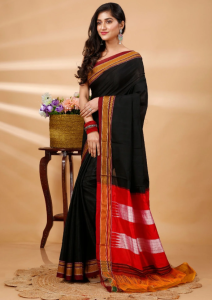
Image – Source
Ilkal Saree is another popular traditional dress in Karnataka, especially known for its distinct weaving style. This saree is named after the town of Ilkal, where it’s traditionally produced.
Characterized by its deep colours and contrasting pallu design, the Ilkal saree is a common sight during festive celebrations and religious events.
The saree is made of cotton or a cotton-silk blend, offering both comfort and elegance.
The pallu (end part) often features red, white, and green bands, symbolic of traditional Karnataka motifs. It’s widely worn in rural and urban Karnataka, reflecting the rich cultural fabric of the state.
Ilkal Saree Details
| Feature | Details |
| Dress Name | Ilkal Saree |
| Cultural Significance | Worn during local festivals, religious ceremonies, and rural celebrations. |
| Fabric & Textiles | Typically made from cotton or cotton-silk blend, with a unique contrast pallu design. |
| Design Features | Characterized by deep colours, contrasting pallus, and traditional temple designs. |
| Colour Palette | Dark shades like maroon, green, and blue with contrasting white or red pallus. |
| Wearing Style | Draped in the traditional South Indian style, with pleats at the waist. |
| Occasions for Use | Commonly worn in rural Karnataka during festivals like Ugadi and religious events. |
| Accessories | Paired with simple gold or silver jewellery, depending on the occasion. |
| Craftsmanship | Made using traditional weaving methods, with a focus on durability and cultural authenticity. |
| Cultural Importance | Reflects Karnataka’s rich weaving tradition, particularly from the town of Ilkal. |
| Modern Variations | Cotton-silk blends are gaining popularity for daily wear with modern patterns. |
| Embroidery and Zari Work | Some Ilkal sarees feature minimal zari work to enhance the elegance. |
| Traditional Weaving Techniques | Woven using the traditional pit loom, famous for its durability and long-lasting quality. |
| Historical Legacy | Historically worn by rural women, it is now gaining urban recognition. |
| Environmental Sustainability | Primarily uses organic cotton in its production, supporting eco-friendly practices. |
| Symbol of Karnataka Identity | Represents the everyday culture of rural Karnataka. |
| Enduring Popularity | Remains a staple attire in rural Karnataka and is growing in urban popularity. |
3. Kanchipuram Saree
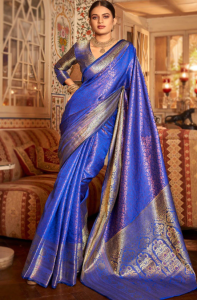
Image – Source
The Kanchipuram Saree, though originally from Tamil Nadu, has found a prominent place in Karnataka’s traditional attire.
Known for its grandeur and thick silk fabric, it is especially worn during weddings and festivals. The saree is loved for its durability and lustrous finish, often passed down through generations.
The saree comes in vibrant colours, often featuring broad gold borders and intricate designs inspired by temples, peacocks, and mythology.
Women in Karnataka treasure these sarees as they symbolize cultural pride and are often worn during key life events.
Kanchipuram Saree Details
| Feature | Details |
| Dress Name | Kanchipuram Saree (Kanjeevaram) |
| Cultural Significance | Worn by women during weddings, festivals, and important religious ceremonies. |
| Fabric & Textiles | Made from thick, high-quality silk with a lustrous finish. |
| Design Features | Features intricate designs, usually inspired by temples, peacocks, and mythology. |
| Colour Palette | Bold colours like red, gold, blue, and green, with broad golden borders. |
| Wearing Style | Draped with several pleats, with the pallu over the shoulder, commonly used for bridal wear. |
| Occasions for Use | Commonly worn at weddings, Dussehra, and other major Karnataka festivals. |
| Accessories | Paired with elaborate gold jewellery, such as heavy necklaces, earrings, and bangles. |
| Craftsmanship | Handcrafted by skilled weavers, with intricate patterns and zari work. |
| Cultural Importance | Considered one of the most prestigious sarees in South Indian culture. |
| Modern Variations | Lighter versions are available for casual functions with less heavy zari work. |
| Embroidery and Zari Work | Known for extensive gold zari embroidery along the borders and pallus. |
| Traditional Weaving Techniques | Famous for the double-weave technique, making the saree extremely durable. |
| Historical Legacy | Worn by royalty and brides, symbolizing wealth and heritage. |
| Environmental Sustainability | Efforts are being made to integrate eco-friendly silk production methods. |
| Symbol of Karnataka Identity | Though from Tamil Nadu, the Kanchipuram saree is beloved across Karnataka for weddings. |
| Enduring Popularity | Remains an enduring symbol of luxury and bridal wear. |
4. Lambani Dress
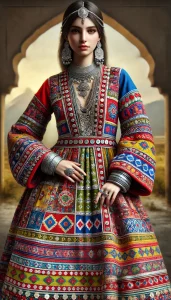
The Lambani dress is a vibrant and intricately designed traditional outfit worn by the Lambani women, a semi-nomadic tribe in Karnataka.
Known for its bright colours and mirror work, this dress is a true reflection of the community’s artistic heritage.
The attire is often complemented by heavy silver jewelry, further enhancing its cultural significance.
Typically made from cotton, the Lambani dress is adorned with embroidery, patchwork, and glasswork, symbolizing the tribe’s deep-rooted connection with nature.
This dress is worn by women during festivals, celebrations, and daily life, making it both practical and culturally significant.
Lambani Dress Details
| Feature | Details |
| Dress Name | Lambani Dress |
| Cultural Significance | Traditional attire of the Lambani tribe, worn during festivals and celebrations. |
| Fabric & Textiles | Typically made from durable cotton, heavily embellished with mirror work and embroidery. |
| Design Features | Rich in patchwork, mirrorwork, and intricate embroidery. |
| Colour Palette | Bright hues like red, blue, and yellow, with contrasting patchwork. |
| Wearing Style | Worn as a long flowing skirt, with a blouse and headscarf. |
| Occasions for Use | Worn during tribal festivals, cultural celebrations, and in everyday life. |
| Accessories | Paired with heavy silver jewellery, including necklaces, earrings, and bangles. |
| Craftsmanship | Handcrafted with intricate embroidery and mirror work. |
| Cultural Importance | Reflects the semi-nomadic lifestyle of the Lambani tribe and their connection to nature. |
| Modern Variations | Some modern versions come with lighter mirror work for casual wear. |
| Embroidery and Zari Work | Features bold embroidery, mainly on skirts and headscarves. |
| Traditional Weaving Techniques | Utilizes traditional hand-stitching techniques passed down through generations. |
| Historical Legacy | A historically significant outfit symbolizing the identity of the Lambani people. |
| Environmental Sustainability | Often made with natural dyes and materials sourced locally. |
| Symbol of Karnataka Identity | Represents the tribal culture of Karnataka, especially in rural areas. |
| Enduring Popularity | Continues to be a significant part of the Lambani community’s attire, with growing urban interest. |
5. Coorgi Saree (Kodagu Saree)
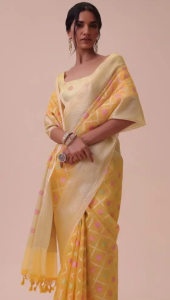
Image – Source
The Coorgi or Kodagu saree is a unique traditional dress worn by the women of the Kodava community in Coorg (Kodagu) district.
Unlike other sarees, it is draped differently, with the pleats tucked at the back and the pallu brought over the right shoulder, creating a distinctive style.
This saree is primarily worn during weddings, festivals, and traditional Kodava ceremonies.
Made from various materials, including silk and cotton, the Coorgi saree reflects the simple yet elegant lifestyle of the Kodava people.
Its distinct draping style and cultural significance make it a treasured garment for special occasions.
Coorgi Saree Details
| Feature | Details |
| Dress Name | Coorgi Saree (Kodagu Saree) |
| Cultural Significance | Worn by Kodava women during weddings, festivals, and traditional ceremonies. |
| Fabric & Textiles | Made from silk or cotton, depending on the occasion. |
| Design Features | Features minimalistic designs with a unique draping style. |
| Colour Palette | Predominantly white, cream, or red, often with simple borders. |
| Wearing Style | Draped with the pleats tucked at the back and the pallu draped over the right shoulder. |
| Occasions for Use | Worn during Kodava weddings, Puthari festival, and family ceremonies. |
| Accessories | Paired with traditional Kodava jewellery, including necklaces and bracelets. |
| Craftsmanship | Handwoven with simple yet elegant patterns, focusing on the draping style. |
| Cultural Importance | Symbolizes the distinct identity and customs of the Kodava community. |
| Modern Variations | Modern versions include lighter fabrics and softer designs for casual wear. |
| Embroidery and Zari Work | Minimal embroidery or zari work, focusing on the drape rather than embellishments. |
| Traditional Weaving Techniques | Typically handwoven using traditional looms, focusing on simplicity. |
| Historical Legacy | A historical representation of Kodava women’s attire, dating back centuries. |
| Environmental Sustainability | Locally sourced materials and eco-friendly dyes are often used. |
| Symbol of Karnataka Identity | Represents the rich heritage and customs of the Kodava people in Karnataka. |
| Enduring Popularity | Continues to be worn by Kodava women on special occasions and festivals. |
6. Panche (Dhoti)
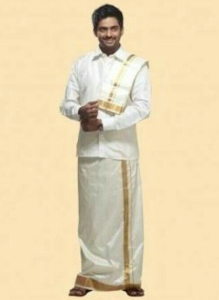
Image – Source
The Panche, also known as the dhoti, is a traditional male garment commonly worn in Karnataka.
Made from cotton or silk, the Panche is a long piece of unstitched cloth, wrapped around the waist and legs, creating a comfortable yet formal appearance.
It is worn by men during religious ceremonies, festivals, and daily life in rural areas.
The Panche holds cultural significance, symbolizing simplicity and humility. While it is often worn in its plain white form, certain variations may include borders with gold thread, especially for special occasions.
Panche Dress Details
| Feature | Details |
| Dress Name | Panche (Dhoti) |
| Cultural Significance | Worn by men during religious ceremonies, festivals, and cultural events. |
| Fabric & Textiles | Typically made from cotton or silk, depending on the occasion. |
| Design Features | Simple, unstitched cloth, often with a border for formal wear. |
| Colour Palette | Primarily white or cream, with occasional gold or coloured borders. |
| Wearing Style | Wrapped around the waist and legs, with pleats at the front. |
| Occasions for Use | Commonly worn during religious rituals, weddings, and cultural celebrations. |
| Accessories | Paired with an Angavastram (shoulder cloth) for formal occasions. |
| Craftsmanship | Handwoven using traditional techniques, focusing on comfort and simplicity. |
| Cultural Importance | Represents the simplicity and humility of Karnataka’s rural traditions. |
| Modern Variations | Silk versions with decorative borders are worn during weddings and festivals. |
| Embroidery and Zari Work | Occasional gold or silver zari work on the borders for festive versions. |
| Traditional Weaving Techniques | Typically handwoven on traditional looms, using cotton or silk. |
| Historical Legacy | Worn by men across generations, particularly in rural Karnataka. |
| Environmental Sustainability | Often made from organic cotton, promoting eco-friendly practices. |
| Symbol of Karnataka Identity | A key symbol of traditional male attire in rural Karnataka. |
| Enduring Popularity | Continues to be worn in rural Karnataka and during religious ceremonies. |
7. Lungi with Angavastram
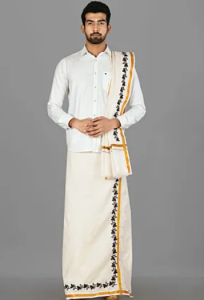
Image – Source
The lungi, paired with an Angavastram, is another traditional male attire commonly seen in Karnataka.
The lungi is a casual piece of cloth wrapped around the waist, while the Angavastram is a shoulder cloth worn for added modesty and style.
This combination is especially popular in rural areas, where it serves as both casual and festive wear.
Made from cotton, the lungi is comfortable and breathable, making it ideal for Karnataka’s warm climate.
The Angavastram adds a touch of formality to this simple outfit, often worn during casual gatherings and cultural events.
Lungi with Angavastram Dress Details
| Feature | Details |
| Dress Name | Lungi with Angavastram |
| Cultural Significance | Worn by men during casual and festive occasions, particularly in rural areas. |
| Fabric & Textiles | Made from cotton for comfort and breathability. |
| Design Features | Simple, unstitched cloth wrapped around the waist, paired with a shoulder cloth. |
| Colour Palette | Commonly in checked patterns, with earthy tones like brown, green, and blue. |
| Wearing Style | Wrapped around the waist, while the Angavastram is draped over the shoulder. |
| Occasions for Use | Worn during casual gatherings, festivals, and cultural events. |
| Accessories | Paired with simple sandals and occasionally a turban. |
| Craftsmanship | Handwoven with a focus on comfort, using soft cotton fabrics. |
| Cultural Importance | Represents the traditional rural lifestyle of Karnataka. |
| Modern Variations | Lungi styles with modern patterns and lighter fabrics are gaining popularity. |
| Embroidery and Zari Work | It rarely features embroidery; the focus is on the fabric and pattern. |
| Traditional Weaving Techniques | Handwoven using traditional looms, focusing on lightweight and breathable textiles. |
| Historical Legacy | A traditional garment worn by men in rural areas for centuries. |
| Environmental Sustainability | Made from eco-friendly cotton, supporting local farmers. |
| Symbol of Karnataka Identity | Widely worn across rural Karnataka, it symbolises the everyday culture of the region. |
| Enduring Popularity | Continues to be popular as casual wear in rural Karnataka and some urban areas. |
8. Sherwani
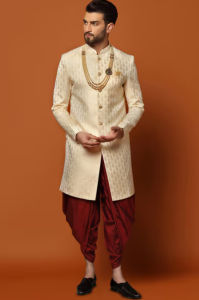
Image – Source
The Sherwani is a formal traditional outfit for men in Karnataka, especially worn during weddings and festivals.
Though it has Mughal origins, the Sherwani has become an integral part of Karnataka’s wedding attire.
It is a long coat-like garment, often paired with churidar (fitted trousers) or dhoti, making the wearer appear regal and elegant.
Sherwanis are typically made from silk or brocade and feature intricate embroidery, often with zari work.
The outfit exudes grandeur and is a popular choice for grooms and men attending weddings and grand festivals like Dussehra. Its rich textures and designs make it a timeless piece of traditional clothing.
Sherwani Dress Details
| Feature | Details |
| Dress Name | Sherwani |
| Cultural Significance | Worn by men during weddings, formal events, and festivals, symbolizing status and tradition. |
| Fabric & Textiles | Usually made from silk, brocade, or velvet, with rich textures and embroidery. |
| Design Features | Long coat-like garment with embroidery, often adorned with gold or silver thread. |
| Colour Palette | Typically in rich shades like gold, maroon, and navy blue, with zari embellishments. |
| Wearing Style | Worn over a churidar or dhoti, with the coat fastened in the front. |
| Occasions for Use | Commonly worn by grooms during weddings, festivals, and high-profile events. |
| Accessories | Paired with a turban, mojari shoes, and sometimes a shawl. |
| Craftsmanship | Handcrafted with fine embroidery, including intricate zari work and embellishments. |
| Cultural Importance | Symbolizes prestige and cultural pride, particularly during weddings. |
| Modern Variations | Contemporary versions include lightweight fabrics and simpler designs for semi-formal events. |
| Embroidery and Zari Work | Rich zari work is often used to enhance the regal appearance of the Sherwani. |
| Traditional Weaving Techniques | Often handwoven, focusing on luxurious textiles and detailed embroidery. |
| Historical Legacy | Originally a Mughal attire, adopted in Karnataka for formal occasions. |
| Environmental Sustainability | Sherwanis are increasingly made with sustainable fabrics like organic silk. |
| Symbol of Karnataka Identity | Adopted as a formal attire, it represents grandeur and tradition during weddings. |
| Enduring Popularity | Continues to be a favorite for wedding ceremonies and other formal occasions. |
9. Kurta Pyjama
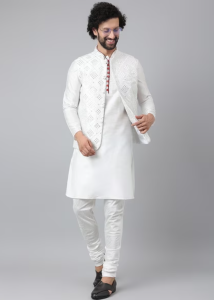
Image – Source
The Kurta Pyjama is a staple traditional dress for men in Karnataka, commonly worn during festivals, family gatherings, and religious events.
The kurta, a loose-fitting shirt, is paired with pyjama, a comfortable pair of trousers. It is a versatile outfit, suitable for both casual and formal occasions.
Made from cotton, silk, or linen, the Kurta Pyjama is available in various styles and colours, often adorned with minimal embroidery for a festive look.
Its simplicity and elegance make it a timeless choice for men across Karnataka, especially during festivals like Ugadi and Diwali.
Kurta Pyjama Dress Details
| Feature | Details |
| Dress Name | Kurta Pyjama |
| Cultural Significance | Worn by men during festivals, family gatherings, and religious ceremonies. |
| Fabric & Textiles | Commonly made from cotton, silk, or linen, ensuring comfort and elegance. |
| Design Features | Loose-fitting kurta paired with pyjama, sometimes embellished with simple embroidery. |
| Colour Palette | Available in various colours, from pastels to rich shades, often in white for religious events. |
| Wearing Style | Worn with the kurta hanging loosely over the pyjama, offering a relaxed yet formal look. |
| Occasions for Use | Worn during festivals like Ugadi, Diwali, and family ceremonies. |
| Accessories | Paired with simple sandals, a shawl, or a turban for more formal events. |
| Craftsmanship | Typically handcrafted with light embroidery, focusing on comfort and style. |
| Cultural Importance | Represents simplicity and tradition, making it ideal for casual and formal occasions. |
| Modern Variations | Modern kurtas feature contemporary cuts and fabrics, appealing to younger generations. |
| Embroidery and Zari Work | Light embroidery or zari work may be added for festive occasions. |
| Traditional Weaving Techniques | Handwoven using natural fabrics, with a focus on comfort and breathability. |
| Historical Legacy | A traditional dress worn for generations, symbolizing Karnataka’s cultural roots. |
| Environmental Sustainability | Often made from eco-friendly fabrics, promoting sustainable fashion. |
| Symbol of Karnataka Identity | A versatile outfit representing both tradition and modernity in Karnataka. |
| Enduring Popularity | Continues to be a popular choice for men during festivals and family events. |
10. Kuppasa (Coorgi Men’s Attire)
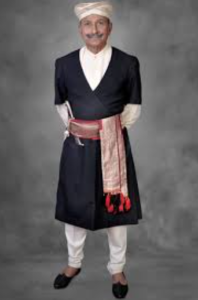
Image – Source
The Kuppasa, part of the traditional attire worn by the men of Coorg (Kodagu), is a knee-length coat often paired with a turban and dagger.
This outfit reflects the warrior culture of the Kodava community and is worn during special occasions, particularly weddings and religious ceremonies.
The Kuppasa is made from a simple cotton or wool fabric, usually black, brown, or white. Worn with a traditional sash and a headgear known as “Mande Tuni,” this attire embodies the rich heritage of the Kodava people, symbolizing both dignity and strength.
Kuppasa Dress Details
| Feature | Details |
| Dress Name | Kuppasa (Coorgi Men’s Attire) |
| Cultural Significance | Worn by Kodava men during weddings, festivals, and traditional ceremonies. |
| Fabric & Textiles | Made from cotton or wool, depending on the season, with a simple design. |
| Design Features | Knee-length coat paired with a sash, turban, and a dagger for formal occasions. |
| Colour Palette | Traditionally in black, brown, or white, reflecting the dignity of the Kodava community. |
| Wearing Style | Worn with the coat fastened by a sash and a turban wrapped around the head. |
| Occasions for Use | Commonly worn during Kodava weddings, Puthari festival, and religious ceremonies. |
| Accessories | Paired with a traditional dagger (odi kathi) and turban (Mande Tuni). |
| Craftsmanship | Handcrafted with attention to detail, reflecting the warrior heritage of the Kodava people. |
| Cultural Importance | Represents the warrior culture and traditions of the Kodava community. |
| Modern Variations | Some modern versions come with lighter fabrics and less formal designs for casual wear. |
| Embroidery and Zari Work | Minimalistic, with a focus on simplicity rather than heavy embellishments. |
| Traditional Weaving Techniques | Typically handwoven, with a focus on durability and cultural authenticity. |
| Historical Legacy | A historical attire symbolizing the pride and strength of Kodava men. |
| Environmental Sustainability | Often made with locally sourced natural fabrics. |
| Symbol of Karnataka Identity | Represents the unique culture of Coorg, part of Karnataka’s diverse heritage. |
| Enduring Popularity | Continues to be a symbol of pride for Kodava men, especially during important events. |
Conclusion
The traditional dresses of Karnataka serve as a testament to the state’s rich cultural diversity and historical significance.
Each outfit, whether it’s the regal Sherwani or the graceful Ilkal saree, encapsulates the essence of Karnataka’s ethnic heritage and craftsmanship.
These garments continue to play a pivotal role in festivals, weddings, and special occasions, symbolizing unity, pride, and tradition.
As Karnataka embraces modernity, its traditional attire remains an integral part of its identity, blending contemporary influences with age-old customs.
Preserving these traditional clothes is not only about maintaining a connection to the past but also about celebrating the vibrant and enduring culture that defines Karnataka, making it a state where heritage and modernity coexist beautifully.
FAQs About Karnataka Traditional Dress
What are the main traditional dresses for women in Karnataka?
Karnataka’s traditional dresses for women include the Mysore Silk Saree, Ilkal Saree, Kanchipuram Saree, Lambani Dress, and Coorgi Saree, each with its unique cultural significance.
What is the significance of Mysore silk sarees?
Mysore Silk Sarees are known for their luxurious texture and intricate gold zari work, symbolizing Karnataka’s rich textile tradition. They are often worn during festivals and weddings.
How is the Coorgi saree worn?
The Coorgi saree is draped differently, with pleats tucked at the back and the pallu brought over the right shoulder, reflecting the unique tradition of the Kodava community.
What do men wear traditionally in Karnataka?
Traditional male attire in Karnataka includes the Panche (dhoti), Lungi with Angavastram, Sherwani, Kurta Pyjama, and the Kuppasa worn by Kodava men.
What is the cultural importance of the Panche in Karnataka?
The Panche, also known as the dhoti, is a symbol of simplicity and cultural pride, commonly worn during religious ceremonies, festivals, and formal occasions.
Are the traditional dresses of Karnataka worn during festivals?
Yes, traditional dresses like the Mysore Silk Saree, Panche, Sherwani, and others are commonly worn during festivals like Dussehra, Ugadi, and religious ceremonies.
How are Karnataka’s tribal dresses different from mainstream traditional attire?
Karnataka’s tribal dresses, like the Lambani dress, feature bright colours, mirror work, and intricate embroidery, reflecting the artistic heritage of the state’s Indigenous communities.

